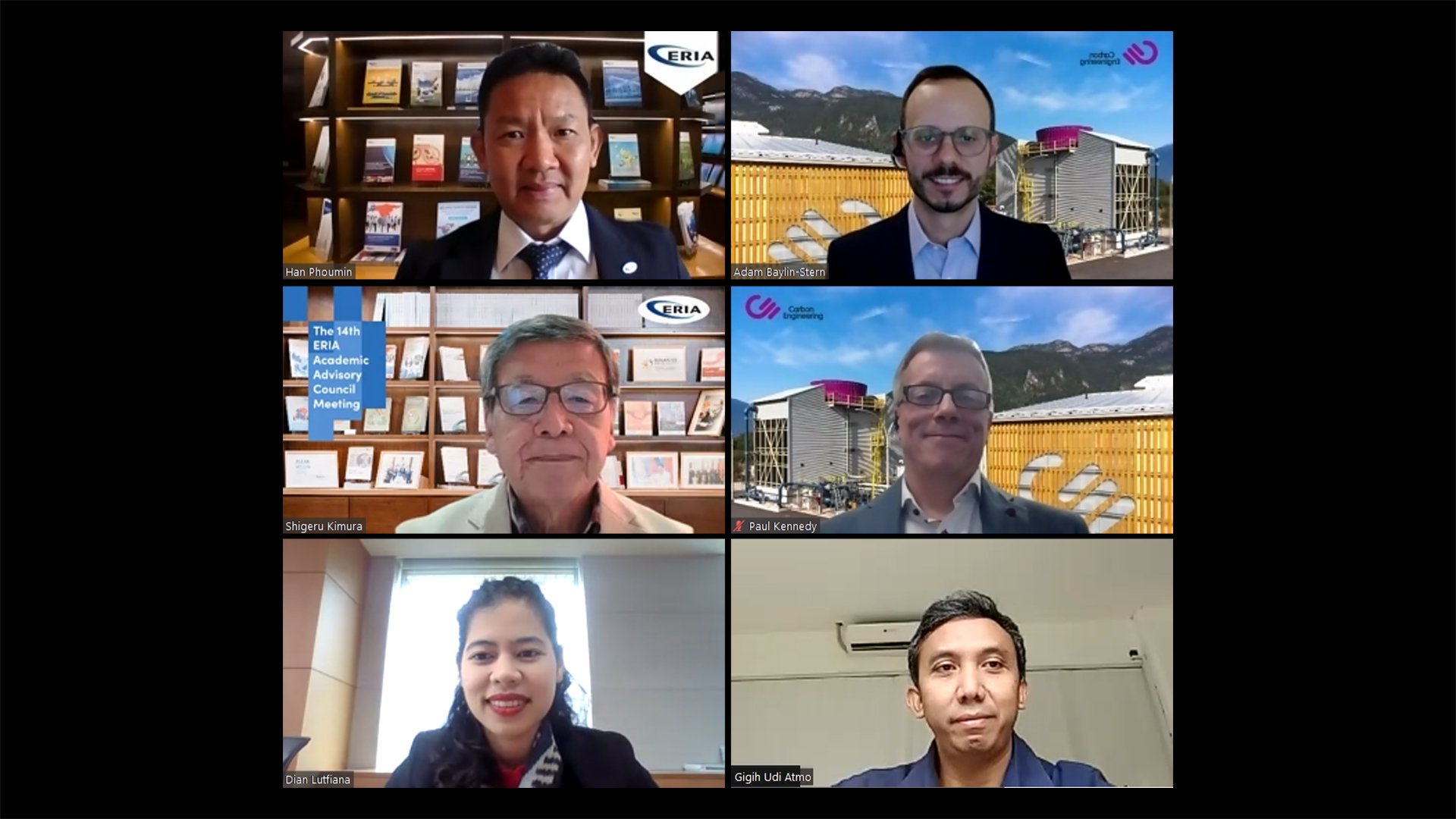Leading Canadian Company Talks Climate Technology and Direct Air Capture Opportunities in Asia at 6th ACN Knowledge Sharing Conference
The 6th Knowledge Sharing Virtual Conference, 31 January 2023: Canadian company Carbon Engineering’s work in the commercialisation of direct air capture (DAC) technology offers the Asian region rich insights into the potential benefits and opportunities of this important carbon dioxide removal (CDR) innovation. With restricted time to cap global warming from exceeding 1.5°C and to prevent irreversible climate effects, DAC technology is a complementary solution to decarbonise hard-to-abate industries as well as to remove carbon dioxide (CO2) emissions on a large scale. As Asia and ASEAN move forward with their emissions reduction journey, DAC offers numerous advantages to support the region’s energy transition process. Carbon Engineering’s guest speakers collaborated with the Economic Research Institute for ASEAN and East Asia (ERIA) – the secretariat of the Asia CCUS Network (ACN) – during the 6th ACN Knowledge Sharing Conference to share their ongoing work on DAC and how it can be beneficial for the region, particularly, Southeast Asia.
Mr Shigeru Kimura, Special Advisor to the President on Energy Affairs, ERIA made the Opening Remarks where he underscored how the application of this CDR innovation can be useful to combat carbon-intensive sectors, such as in coal and gas, power plants, cement, and iron and steel. Mr Kimura closed his speech by praising Carbon Engineering’s contribution to the event as it provided ‘a good opportunity for us to understand DAC in terms of the current technical and economic situation and CO2 removal costs.’
Mr Paul Kennedy, Vice President of International Business Development, Carbon Engineering set the scene on durable CDR solutions like DAC for the Asian region. Four key points are regularly mentioned during discussions on achieving carbon neutrality, namely:
Asia has a longstanding history of working together to solve regional challenges.
Asia requires a full range of decarbonisation solutions in which regional cooperation is at the centre of ensuring those solutions are applied.
Several countries in Asia have the resources to support the implementation of DAC projects encompassing suitable reservoirs for sequestrations and a trained engineering and operations workforce.
The need to leverage the abundant resources to drive international investment in climate change solutions to champion a just transition.
Mr Kennedy added that Carbon Engineering is in the commercialisation phase of DAC and seeks to assist the company’s partners to ‘realise the benefits of durable carbon removal at climate-relevant scale.’
Dr Han Phoumin, Senior Energy Economist, ERIA served as the moderator of the Presentation and Commentary Sessions entitled ‘Direct Air Capture: The Opportunity in Asia’ explaining how DAC is a promising technology that can be swiftly upscaled hence making it beneficial in the near future.
The sole presenter at the event, Mr Adam Baylin-Stern, Policy and Engagement Lead, Carbon Engineering covered five main areas in his presentation, namely the importance of DAC, the technology and deployment of DAC, Carbon Engineering’s projects, Asia’s opportunity, and the policy types to unlock the economic benefits of the technology. In his initial remark, Mr Baylin-Stern stated that as a carbon removal technology, DAC ‘can be a valuable economic opportunity.’ The urgency of energy transition coupled with the tough task of realising carbon neutrality and net-zero emissions necessitate the commercialisation of various carbon removal solutions. Annually, CO2 emissions rise at around 2 parts per million (PPM) and more significantly, the world has less than 7.5 years remaining on the carbon clock before the temperature rise reaches 1.5°C. Mr Baylin-Stern stipulated that after deploying all possible emissions removal and reduction strategies, 1 trillion tonnes of CO2 will remain and must be removed. Mr Baylin-Stern stated, ‘It’s absolutely critical that we reduce emissions from all across the economy to the greatest extent possible and that we complement this with carbon removal’ and DAC is one such approach.
The technology directly captures CO2 from the air around us and binds the air into potassium hydroxide before undergoing two different chemical cycles to be purified and can, later on, be used or stored similar to Carbon, Capture, Storage (CCS) applications. The primary advantage of DAC is that it can be placed anywhere in the world because it does not need to be close to an emissions source. According to Mr Baylin-Stern, Carbon Engineering’s DAC design features are based ‘on existing industrial equipment that has an industrial precedent, so it is really a configuration of different pieces of industrial equipment that are already used in the sectors of the economy today.’ Moreover, it was designed to operate at a megatonne scale thus it is optimised ‘to give the best, most cost-effective performance when done at a large scale.’ For these reasons, he is confident that the company’s technology can be deployed globally and have a meaningful impact on climate change.
Since pioneering large-scale DAC in 2009, Carbon Engineering has since built a pilot plant in 2015 and an innovation centre in 2021 in Squamish, Canada. Together with its partner, 1PointFive, the company began construction of the DAC-1 Facility in Texas, USA in 2022 which will have a capacity of removing 500,000 tonnes of CO2 per year and the potential to scale up to 1 megatonne per year; ongoing projects are also underway in the UK, Norway, and other parts of Canada.
As a DAC company, Carbon Engineering sees several opportunities for Asia to catapult its net-zero transition. Mr Baylin-Stern mentioned five reasons:
Excellent storage potential across the region, particularly in Indonesia, Malaysia, and Thailand.
The availability of clean energy in the region.
The strength of channels to markets and customers
The abundance of highly skilled labour from relevant sectors.
The development of supportive policies and incentives.
Government support and supportive policies will aid in the effective launch of DAC as it puts a price on CDR initiatives, creates a climate investment and viable long-term markets, and opens up job and transition opportunities. Further, there are three types of policies to kickstart DAC deployment: market creation policies, financial support policies, and market facilitation policies. Mr Baylin-Stern ended his presentation by underlining the significance of regions working together to take advantage of certain countries’ strengths, such as for sequestration potential, which could unlock the economic potential that exists and support a DAC industry.
Dr Gigih Udi Atmo, Director of Energy Conservation, Ministry of Energy and Mineral Resources (MEMR), Indonesia led the Commentary Session. He expressed the MEMR’s interest in DAC technology and how it can be applied following recent strides in Indonesia concerning its energy transition process. Indonesia is poised to reach peak emissions between 2035 – 2040 with the energy sector expected to contribute 700-800 million tonnes of CO2 during this period. Dr Atmo also shared that as Indonesia moves toward the year 2060, the sector’s emissions contribution will be reduced to up to 129 million tonnes of CO2. Dr Atmo also inquired to the Carbon Engineering team regarding certain methodologies and standards that are currently available to certify carbon removal through DAC and the representatives’ thoughts on DAC within Indonesia’s emissions trading systems.
Mr Baylin-Stern praised Indonesia’s Chairmanship during the G20 Summit in 2022 and the country’s various progress concerning policies, pricing systems, and carbon capture applications. On methodologies and standards, Mr Baylin-Stern stressed the importance of ensuring transparent and rigorous standards and guidelines associated with carbon removal. Such measures would boost the confidence of buyers and the governments who establish the policies and regulatory framework that DAC is a high-quality CDR innovation. Further, a strong guideline facilitates a clear accounting for emissions across countries which is crucial at the international level. Moreover, Indonesia can incentivise DAC as a negative emissions activity which would support the market. Another option is a ‘contract for difference’ that ‘would provide a price guarantee to developers generating emissions reduction’ where the difference between the activity and carbon price can be granted through schemes such as subsidies.
Mr Kennedy added that there is a wide range of existing policies on emissions trading systems that differ per country which denotes that ‘it really depends on what works best for the economy and the taxation approach that the different governments take.’ Furthermore, Mr Kennedy stated that today, the cost of using DAC varies from $350-$425 per tonne of CO2 removed, however, it is expected to reach the range of $100-$150 per tonne of CO2 between 2030 – 2035. Despite these costs, Mr Kennedy cautioned, ‘One of the important things to remember is if we do not start building plants today, when we get to the need of the gigatonnes removal out in the 2040s and 2050s, they won’t be there.’ As such, it is crucial to deploy more DAC technologies and push for its commercialisation to drive down costs.
The Q&A Session featured several technical questions about Carbon Engineering’s projects, the feasibility of DAC in Asia, and the types of integrated policies to ensure the realisation of DAC in Thailand and Southeast Asia. Mr Baylin-Stern explained that Indonesia’s renewables and CO2 storage potential as well as its history of CO2 injection, previous cooperation, and emerging policies make the country an ideal candidate for Carbon Engineering to implement its technology in Asia. Besides DAC’s location-independent attribute, Mr Baylin-Stern believes that this innovation is an ‘excellent tenant within a hub development given that they have a stable output of CO2 so they can be valuable components of a storage hub.’ Ultimately, Carbon Engineering’s objectives with its projects are to reduce the carbon footprint of the plant and drive down the costs as low as possible from both inputs and construction. Mr Kennedy shared that while DAC currently uses potassium hydroxide as its absorption liquid, the company’s innovation centre is actively engaged in advanced development activities which could see improvements in the type of liquid used.
Regarding the realisation of DAC in Southeast Asia, Mr Kennedy suggested a step-by-step approach to integrating DAC into Southeast Asia’s policies with clear regulations that DAC and CCS can be safely conducted under existing laws. It is crucial that governments ‘consider DAC and carbon removal as you create those carbon policies’ and connect with other countries on a bilateral or multilateral level to explore ways to include DAC in trade or climate agreements. Mr Baylin-Stern emphasized that ‘the underlying policy environment is critical as a first step regulation’. Countries can then proceed with market creation to establish an industry followed by the idea of linking markets to further support the industry.
Based on the information provided during the event, Dr Atmo sees the potential of including DAC as part of the solution to achieving net-zero in Indonesia although the country currently relies heavily on optimising its renewable energy resources and decarbonising the power sectors to become carbon neutral. ‘There is an opportunity to introduce technologies like DAC to capture the emissions from the industry particularly heavy industries like cement, iron and steel,’ Dr Atmo commented.
Dr Phoumin provided the Closing Remarks where he called for continued effort ‘to reduce emissions at source and remove CO2 from the atmosphere at large scale.’ There is a greater need to ensure the affordability, scalability, and cost-competitiveness of CDR solutions, such as DAC and CCS, in the near future which will require private sector involvement, policy instruments, and government support. ‘Through developing the right policies and incentives, DAC technologies will be a game changer in reducing emissions from the atmosphere,’ Dr Phoumin stipulated. With limited time to keep global temperatures below 1.5°C, the speed and adoption of CDR solutions emphasise the significance of capacity building which the ACN is ready to assist with.

